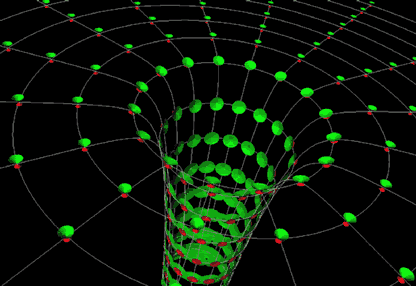
Gravity is one of the most familiar forces we experience in everyday life. For example, when we climb the stairs we experience the force of gravity. In fact all forms of matter and energy produce gravitational fields and are acted on by gravity. This is different from electric fields, for example, which only exert a force on charged objects. On average most large bodies are electrically neutral so the electric forces cancel out. For gravitational forces on the other hand there is no cancellation but instead the individual effects add up, so the larger the object the more important the gravitational force.
If one throws a ball up in the air then the faster one throws it upwards, the higher it goes before returning to earth. If one throws it sufficiently fast it never returns to earth. This speed is called the escape velocity. The escape velocity depends upon the strength of the gravitational field. For example the escape velocity for the Earth is 11.2 km per second, but on the Moon where the gravitational field is weaker the escape velocity is only 2.4 km per second. If we take this idea to the extreme we can stars whose gravitational field was so strong that the escape velocity was greater than the speed of light, so that not even light could escape from the star. Such objects are known as black holes.
| Of all the conceptions of the human mind from unicorns to gargoyles to the hydrogen bomb perhaps the most fantastic is the black hole: a hole in space with a definite edge over which anything can fall and nothing can escape; a hole that curves space and warps time. Like the unicorn and the gargoyle, the black hole seems much more at home in science fiction or in ancient myth than in the real universe. Nevertheless, the laws of modern physics virtually demand that black holes exist. In our galaxy alone there may be millions of them. (Kip Thorne 1974) |  |
The idea of black holes is actually very old. It can be traced back more than 200 years to the 27th of November 1783 when, in the rooms of the Royal Society of London, Henry Cavendish reported on a paper by his friend and colleague Reverend John Michell. The paper concerned potentially observable consequences of Newton's universal theory of gravitation. Michell's discussion was based on Newton's theory and the particle theory of light. Speculating that light particles ought to ``be attracted in the same way as all other bodies'', Michell contemplated the possibility that there might exist stars much larger than the sun, for which the escape velocity exceeds the speed of light (that had been known to be roughly 300000 km/s since Ole Romer's observations of Jupiters moons in 1676). Michell suggested how these invisible objects may be detected
... if any other luminous bodies should happen to revolve about them we might still perhaps from the motions of these revolving bodies infer the existence of the central ones.
Not surprisingly, these propositions caused quite a stir among the fellows of the Royal Society. And why should they not? Not only had Michell introduced the revolutionary idea of ``invisible'' stars, he also anticipated the way that these objects would be observed some two hundred years later.
The physics which lead to Michell's dark stars was based on Newton's law of gravity. However our current best description of gravity, Einstein's 1915 Theory of General Relativity, confirms the existence of black holes. As early as 1916 a solution of Einstein's equations was found by Karl Schwarzschild which gives the gravitational field outside a spherically symmetric star. As in the Newtonian case, if the star is sufficiently dense, it is surrounded by a region of spacetime from which light is unable to escape and so forms a black hole. The boundary of this region is called the event horizon.
 |
The circumferential radius of the event horizon is known as the Schwarzschild radius. If we put in the appropriate numerical values we find that the Schwarszchild radius of the Sun is 3 km. In other words, if the Sun were compressed into a radius smaller than this, light could no longer escape from its surface and it would become invisible (a black hole). If we play the same game with our own planet we find that the Earth's Schwarzschild radius is 9 mm! |
Although the Schwarzschild solution showed that black holes are possible in the Theory of General Relativity, it was work by Oppenheimer and Snyder in 1939 which showed that they could form as a result of gravitational collapse.